Research Article Open Access
Genome-Wide Identification of Transition Metal Ion Transporters in Oryza sativa
| Kiranmayi P*, Vijaya Rachel K, Santyasyamala M and Nagamrutha M | ||
| Department of Biochemistry, Institute of Science, GITAM University, India | ||
| Corresponding Author : | Kiranmayi P Department of Biochemistry Institute of Science, GITAM University, India Tel: 0891-2840463 Fax: 0891-2790032 E-mail: kiranmayi.patnala@gmail.com |
|
| Received January 10, 2014; Accepted April 11, 2014; Published April 14, 2014 | ||
| Citation: Kiranmayi P, Vijaya Rachel K, Santyasyamala M, Nagamrutha M (2014) Genome-Wide Identification of Transition Metal Ion Transporters in Oryza sativa. J Rice Res 2:124. doi: 10.4172/jrr.1000124 | ||
| Copyright: © 2014 Kiranmayi P, et al. This is an open-access article distributed under the terms of the Creative Commons Attribution License, which permits unrestricted use, distribution, and reproduction in any medium, provided the original author and source are credited. | ||
Related article at Pubmed Pubmed  Scholar Google Scholar Google |
||
Visit for more related articles at Rice Research: Open Access
Abstract
Transition metals are essential minerals required for normal growth and development of plants which are taken in correct proportions from the soil and distributed throughout the plant. The concentrations of transition metals in roots, shoots and grains were analyzed in Oryza sativa indica cultivars viz., Sona Masuri (BPT 5204), Swarna (MTU 7029) and Vijetha (MTU1001). In roots the concentration of iron was highest in Sona masuri variety, followed by manganese and zinc. In shoots and grains, iron was highest followed by zinc suggesting specific transport mechanisms in all the parts. A total of 55 genes for transition metal ion transport were identified using insilico tools of which 18 involved in zinc/iron transport, 13 for copper, 7 for manganese, 3 for cobalt, 4 for cadmium and 10 transport metal ions belonging to Nramp family. Research carried out on these metal transporters mainly provides insights into the field of rice metal biology.
| Keywords | |
| Oryza sativa; Transition metals; ZIP family; Iron transporters; Zinc transporters | |
| Introduction | |
| Genome wide studies of the major cereals, including rice is being promoted world-wide in order to provide necessary impetus for substantial increase in production with increasing demand for food supplies [1]. The first rice genome sequence made accessible was that of the O. sativa sub sp japonica cv Nipponbare generated by the International Rice Genome Sequencing Project [2]. Andhra Pradesh is the fifth largest state in India where rice is the principal food crop cultivated throughout the state providing food for its growing population. | |
| Transition metals are required for normal growth and development of plants which need to be carefully taken up in correct proportions from the soil through roots and be distributed throughout the plant and properly regulated to maintain homeostasis [3]. The complete catalog of 65 genes invzolved in transport of metal ions in Neurospora crassa were identified using insilico approaches [4]. This type of study was further substantiated by wet lab techniques wherein the copper transporters [5] and Nickel transporter [6] were transporting their respective metal ions in N. crassa. | |
| Zinc (Zn), an essential nutrient in cells, plays a vital role in controlling cellular processes such as growth, development and differentiation. Five ZIP transporter genes have been reported for rice- OsIRT1, OsIRT2, OsZIP1, OsZIP3, and OsZIP4. OsIRT1 and OsIRT2 are ferrous iron transporters [7]. OsZIP1 is primarily associated with metal uptake and OsZIP3 with overall Zn homeostasis in the cell, especially in leaves [8]. | |
| The Nramps (Natural resistance associated macrophage proteins) are involved in metal ion transport of manganese and iron. In plants, this family was first identified in rice where three Nramps (OsNramp 1-3) were reported [9]. Till date, very little is known about the molecular mechanisms involved in transition metal transport across cell membranes in rice plant. The present work gives more emphasis on the presence of transition metal ion concentrations in three different plant varieties (BPT5204, MTU7029 and MTU1001) and identification of various metal transporter genes and their role involved in the distribution and uptake of these metal ions in O. sativa with the help of an array of insilico tools. | |
| Materials and Methods | |
| Rice varieties used | |
| Sona Masuri (BPT 5204) is one of the fine-grain variety of rice of 150 days duration with an average yield of 6tons/ha grown largely in various parts of Andhra Pradesh. Swarna (MTU 7029) is a semi-dwarf variety of 150 days duration with an average yield of 2.6 tons/ha which can be grown in saline soils. Vijetha (MTU 1001) is a fine variety of grain with 140 days duration, with an average yield of 2.4 tons/ha. | |
| Estimation of metal content in rice plants | |
| The three different rice varieties namely Sona masuri, Swarna and Vijetha were taken and metal content was estimated in roots, shoots and grains during initial and final stages of growth. Metal content of different plant samples (0.5 gms) were determined by subjecting it to wet acid digestion as described by Venkateswarulu and Sastry [10]. 5 ml of concentrated nitric acid and 1 ml of 70% perchloric acid are taken into a 50 ml conical flask, slowly heated to dryness on a sand bath. The residue was further digested with a 1:1 mixture of nitric acid and hydrochloric acid (5 ml) and finally with 10 ml hydrochloric acid. The final residue was dissolved in a suitable volume of deionized distilled water and metal ions estimated by Atomic Absorption Spectrometer (AAS:GBC-932 plus). Data shown are mean values of triplicates from two separate experiments (± SD). | |
| Compilation of catalogue | |
| Transport database, a relational database of a predicted cytoplasmic membrane transport protein complement for organisms was used for building a catalogue of transition metal transporter genes. For the identification of additional proteins, BLAST (Basic Local Alignment Search Tool) program [11], was used with functionally characterized prototype proteins of the other organisms. BLASTP hits are filtered according to high scoring pair algorithm in which each hit confronted by the query was evaluated by how they cover the reference protein. The “query coverage” extends over at least 30% of the reference protein identity is present, in the obtained hits than the hit is retained. The nonredundant protein database from Genbank was used to find out the closest known homologue among all organisms. Open reading frames are identified in the O. sativa genome were BLAST searched against SWISSPROT/TrEMBL database and only functionally characterized proteins in the database were taken into account for assigning predicted role to the proteins encoded by genes in the O. sativa genome. The subcellular localization of the proteins was predicted using TargetP server. Pfam domain search was carried out with the retrieved homologs, using Pfam database. | |
| Phylogenetic analysis | |
| It was performed using CLC’s combined workbench. For this analysis, multiple sequence alignment (MSA) was produced using progressive alignment algorithm [12]. The generated pair-wise alignments were used for finding the evolutionary distance between related transporter genes. Pair wise distances thus calculated were used to create a phylogenetic tree employing un weighted pair group method with arithmetic mean (UPGMA) algorithm with 1000 bootstrap replicates. After this analysis all the properties were merged and final table of transition metal transporters in O. sativa was formatted and annotated. | |
| Results and Discussion | |
| Metal ion concentration at different stages of Oryza sativa | |
| The most commonly consumed three plant varieties (BPT5204, MTU7029, MTU1001) of Oryza sativa were taken. Root, shoot samples were taken at two different stages (Initial and final) of growth and individually subjected to acid digestion, it was observed that in roots, in both the stages (initial & final) the concentration of the metal ion iron was found to be highest in the Sona masuri (BPT5204) variety among all the transition metals considered, followed by manganese and zinc as shown in Figures 1a and 1b. The concentrations of other metals such as cobalt, cadmium and copper were found to be low (Figures 1a and 1b). In comparison to Sona masuri the other two varieties have much lower concentrations of all the transition metals suggesting that it has better gene expression systems rather than the other two (Figures 1a and 1b). | |
| In shoots also, the metal ion concentration of the iron was found to be highest at all stages of growth followed by zinc that has been transported in higher quantities (Figures 2a and 2b). Manganese was transported in medium concentrations and cobalt, cadmium and copper in lower concentrations. | |
| In grains also the highest metal concentrations were observed in the sona masuri rice variety as shown in Figure 3. The grains were more fortified with iron and zinc than the other transition metal ions. The concentration of manganese was decreased indicating less transport of manganese to grains. There is no significant increase or decrease in the concentrations of other elements like cadmium, copper and cobalt and these were transported in lesser concentrations (Figure 3). | |
| Basic features of transition metal ion transporters of Oryza sativa | |
| Plants require a range of transition metals as essential micronutrients for normal growth and development. These transition metal transport system consists of both high and low affinity transporters to maintain the homeostasis in either metal deplete or replete conditions. Some of the transition metals include zinc, iron, cadmium, manganese, copper, cobalt. A complete catalogue of 55 genes with a putative role in transition metal homeostasis of O. sativa were identified and summarized in Table 1. The data presented in table 1 indicated that the transporters for the transition metal zinc outnumbered the rest of the metal ion transporters. Out of 55 transporters only 15 transporters belonging to different families have been identified. Remaining 40 transporters may also play a crucial role in maintaining the homeostasis of different transition metal ions in rice plant. | |
| Zinc transport: Zinc plays many essential and unique biological roles because of its unique chemical characteristics. It is well known that a vast array of proteins use zinc for stabilizing their structures in a functional form [13]. To understand zinc transport in rice, we identified putative zinc transporters in gene databases. O. sativa consists of 18 members belonging to ZIP family that are likely to be involved in zinc uptake as shown in Table 1. Of the 18, five zinc transporters are already characteristics stating their role in zinc transport in rice. The expression patterns of OsZIP1, OsZIP3, and OsZIP4, which encode Zn transporters in rice, were studied and OsZIP1was expressed only in the roots and very weakly in the panicles, while the other two genes were expressed in all parts of the plant. The Zn-deficient conditions up-regulated the expression of OsZIP1, OsZIP3, and OsZIP4 in the roots and that of OsZIP4 in the shoots indicating that all these genes participate in rice zinc nutrition [14]. OsZIP5, which is inducible under Zn deficiency, has complemented the growth defect of a yeast Zn-uptake mutant, indicating that it is a Zn transporte localized to the plasma membrane and plays a role in Zn distribution within rice [15]. | |
| ZIP family was split into several subfamilies based on a higher degree of sequence conservation within these groups that include LIV- 1, ZIP I and ZIP II. ZIP I consists largely of plant and fungal members whereas sub family II is a smaller group of mammalian and nematode proteins. Phylogenetic analysis as shown in Figure 4 predicted two members to be grouped under ZIP I sub-family, eleven in ZIP II family and one in LIV-1 family. One member (Os01g74110) is homologous to ZIP I of Oryza sativa that is mainly induced by zinc or iron depletion [16]. Similarly another member (Os5g10940) is homologous to the zinc transporter 4 in Zea mays which is also helpful in the uptake of zinc. Zinc transporters are more prevalent in ZIP I family but the presence of these transporters in ZIP II family also suggests adaptive mechanisms by these plants for zinc and iron fortification (Figure 4). A comparison of the protein sequences and ionic selectivity suggests that all these transporters may play different roles in the physiology of the whole plant. | |
| Copper transport: Copper is an essential trace element required for many enzymes and proteins involved in various biological processes such as protection against oxidative stress, normal cell growth and development. A Copper Transporter family (Ctr) member carries out copper uptake in lower to higher eukaryotes. The copper (Cu) transporter (COPT/Ctr) gene family has an important role in the maintenance of Cu homeostasis in different species. The Ctr proteins were first identified in Saccharomyces cerevisiae and later it served as a powerful tool for identification of several copper transporter proteins in other fungi, flies, plants and mammals. The characteristic features of these Ctr family members are the presence of two or three transmembrane domains, MXXM and MXM motifs in amino terminal regions, conserved cysteine and histidine residues in carboxy terminus and G4 motif in third transmembrane domain [19]. In Oryza sativa, eight members are found to be present that are involved in transporting copper belonging to Ctr family and five members belonging to P-type ATPases family as shown in Table 1. The rice COPT-type gene family consists of eight members (COPT1 to COPT8) but only two, COPT1 and COPT5, have been characterized for their functions in Cu transport [20]. The phylogenetic analysis as shown in Figure 5 describes that Cu-transporting ATPases are grouped into one cluster and the other copper transporters belonging to Ctr family are grouped into another. | |
| Cadmium transport: Many areas of arable soils in the world are moderately contaminated with cadmium (Cd) through the use of phosphate fertilizers, sludge, and irrigation water containing some levels of Cd. This moderate Cd contamination in soils leads to considerable Cd accumulation in edible parts of the crops, including rice. This is facilitated by CDF family transporters that are ubiquitously represented at all phylogenetic levels responsible for transporting metals like cobalt, cadmium, zinc and nickel. As shown in Figure 3, Sona masuri grains also accumulate Cd due to the presence of four Cd transporters belonging to CDF family and ABC family (Table 1). Phylogenetic analysis predicted that one member of Oryza sativa (Os04g23180) is homologous to the czcD gene of Alcaligenes eutropha which provides resistance to cobalt, zinc and cadmium which is a result of cation efflux system (Figure 6). So this member of O. sativa may also provide resistance to the above mentioned metals. One of the member (Os5g03780) shows striking similarity to a metal tolerance protein alternatively called as ZAT protein in Arabidopsis thaliana that exhibits enhanced zinc resistance and strongly increased zinc content in the roots under high zinc exposure. Thus, we may predict that the gene of the rice species has the possibility of the same behavior. Os04g23180 and Os5g03780 are the members identified in Oryza sativa that may be considered to transport zinc or cadmium. It is also supported by the fact that Cd accumulation is mediated by ability of root-to-shoot Cd translocation via the xylem and is the major physiological process that determines the accumulation in shoots and grains in rice plants [21]. | |
| Manganese transport: Manganese is another essential micronutrient that is required for the growth. Nramp (Natural resistance-associated macrophage proteins) represents a large family of metal transporters that are well conserved from bacteria to mammals that play an important role in transport of iron and manganese [22]. Seven members are identified in Oryza sativa that belong to this group and hence they are assumed to transport manganese (Table 1). In plants, this family was first identified in rice where three Nramps (OsNramp 1-3) were reported. Expression studies in normal plant tissues indicate that OsNramp1 is expressed primarily in roots, while OsNramp2 is primarily expressed in leaves and OsNramp3 is expressed in both tissues [8]. Apart from these seven, having ion selectivity for manganese there are still ten other transporters belonging to this family that may transport manganese. This might be the reason for accumulation of more amount of this metal ion in root, shoot and grains next to iron as shown in Figures 1-3. Clearly, the possibility of Nramp homologues that are implicated in metal transport pathway in plants need to be addressed in a series of plant mutants lacking one or all of the identified OsNramp genes to get a clear picture of its transport. | |
| Nickel/Cobalt transport: Nickel is an essential component of metalloenzymes involved in energy and nitrogen metabolism. Accumulation of nickel is dependent on high affinity uptake of this metal ion from natural environments where they are available only in trace amounts. Cobalt is now recognized as a trance element and is an essential component of many enzymes [23]. NiCoT is the family that is useful for the transportation of Ni/Co metal and it has a conserved signature sequence (RHALDADHI) which is the characteristic feature of this family. There are two members identified in Oryza sativa that belong to this family which are considered to transport Nickel/Cobalt. One member belongs to ABC family which has more specificity to cobalt. However till date the importance of either Ni2+ or Co2+ in O. sativa metabolism has not been understood. | |
| Conclusion | |
| Research carried out on these metal transporters mainly provides insights into the field of rice metal biology. This study helps in figuring out the regulatory networks of metal transporters and assembling the complete picture of transition metal homeostasis. These appealing hypotheses need to be tested experimentally. Quantification of metals in rice tissues experimentally, supports Sona masuri (BPT5204) to be a promising variety both in yield and nutrition with respect to metal ions. The recent advances in biochemical, molecular and genetic techniques including the rapidly expanding use of microarrays and gene knockouts, will definitely help in defining more clearly the specificity, location, regulation and physiological role of these transition metal transporters particularly in plants pertaining to food crops and thereby influence the economy and food security of the nation. | |
| Acknowledgement | |
| Authors are grateful to Regional sugar cane research institute, ANGRAU, Anakapalle (AP), for kind cooperation and help in providing AAS for analyzing plant samples. We are also thankful to GITAM Institute of Science, GITAM University for providing necessary laboratory facilities to carry out this work. | |
References |
|
|
|
Tables and Figures at a glance
| Table 1 |
Figures at a glance
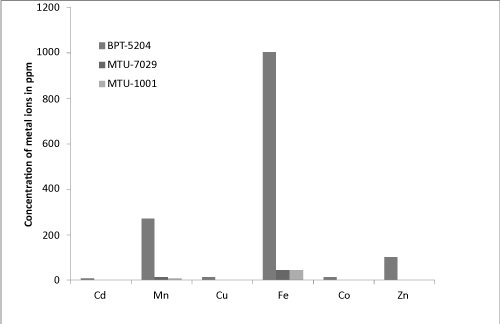 |
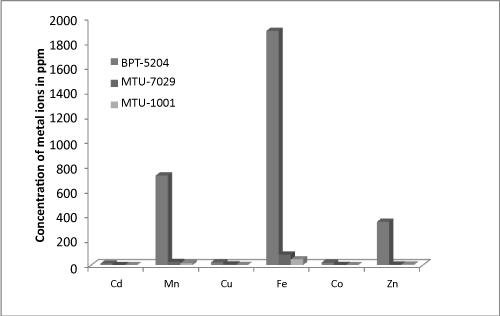 |
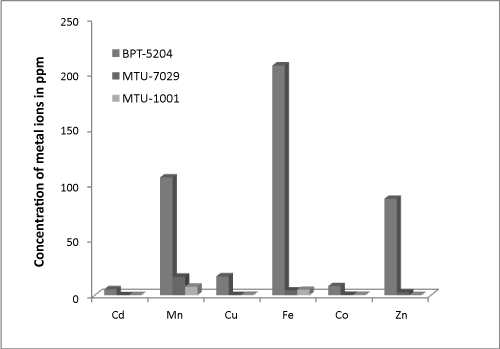 |
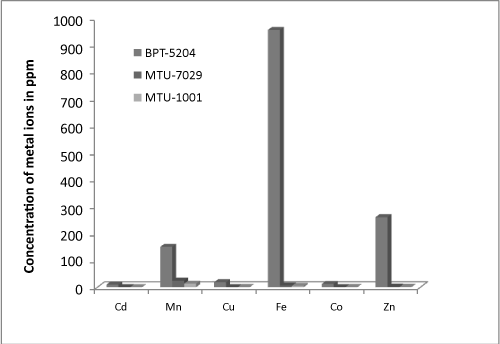 |
|||
| Figure 1a | Figure 1b | Figure 2a | Figure 2b | |||
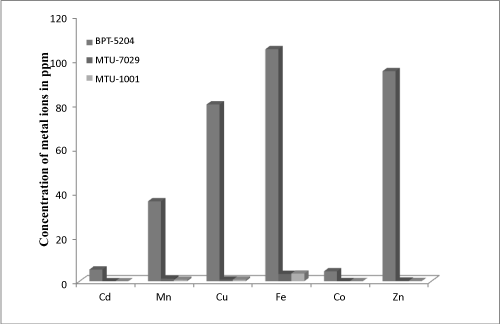 |
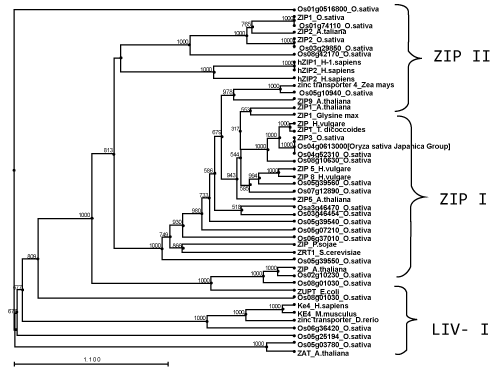 |
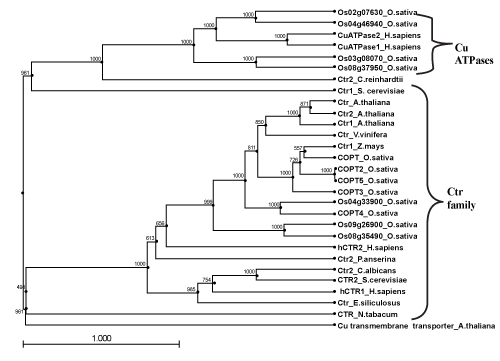 |
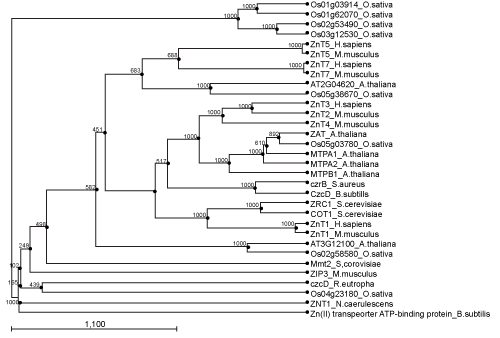 |
|||
| Figure 3 | Figure 4 | Figure 5 | Figure 6 |
Relevant Topics
- Basmati Rice
- Drought Tolerence
- Golden Rice
- Leaf Diseases
- Long Grain Rice
- Par Boiled Rice
- Raw Rice
- Rice
- Rice and Aquaculture
- Rice and Nutrition
- Rice Blast
- Rice Bran
- Rice Diseases
- Rice Economics
- Rice Genome
- Rice husk
- Rice production
- Rice research
- Rice Yield
- Sticky Rice
- Stress Resistant Rice
- Unpolished Rice
- White Rice
Recommended Journals
Article Tools
Article Usage
- Total views: 14774
- [From(publication date):
August-2014 - Jul 02, 2025] - Breakdown by view type
- HTML page views : 10058
- PDF downloads : 4716
